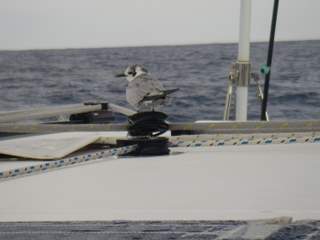Bird,back of cockpit

Tucanon
Dick and Irene Craig
Sat 25 Sep 2010 04:36
to the local time of the place from which we commenced the leg. Once we
arrive in Cocos Keeling. we will be only 6.5hours ahead of UT, so are
gradually clawing back the 24 hours which we lost on arrival in Tonga.
With the wind blowing force 3, east south east, leg 15 was started at noon,
with quite a lot of cloud in the sky. It rained most days that we were in
Bali and certainly each night.
During the first night we were at sea, just off the coast on Indonesia,
Kalliope was concerned about the behaviour of a local boat in the vicinity.
Fortunately that issue was soon solved. There were a great number of WARC
boats nearby at the time, so support was more than adequate, should it have
been necessary.
At least one of the WARC boats hadn't switched on their navigation lights
and was almost hit by another participating boat which had, quite naturally,
not been able to see the unlit boat until almost on top of it. A scary
moment.
We made good speed during the first two days at sea , with the wind blowing
force 4, force 5 at times. By midday on the 15th September, we were unable
to sail at even at four knots and this didn't improve until supper time.
Mid afternoon the following day, a large dorsal fin, less than five metres
from the starboard hull was spotted, along with the sound of a mighty blow.
We didn't see enough of the creature to ascertain what sort of whale that it
was.
We passed Christmas Island, some 60 nautical miles to starboard.
During the night of the 16th we were reduced to 1knot and finally succumbed
to switching on the engines for three hours. This wasn't bad as all the
other boats have used their engines for a considerably longer time than us.
Two of the other boats have done less than ten hours since leaving Bali but
some have done in excess of thirty hours motoring.
Twice we saw a young turtle off to port. They both turned their heads and
looked astonished as we passed them by.
Squadrons of flying fish make way before the boat to port and to starboard.
Whether they think that we are a threat or that there is a predator after
them, I do not know.
A small bird took refuge on the boat around 7pm on the 16th and remained on
board overnight, leaving briefly in the morning but returning and staying
with us until 7.30am, when it finally took its leave of us. While hitching a
ride, the bird explored the cockpit, the flybridge, the coach roof, the
safety items on the guard rail and the roof of the cockpit behind the
flybridge. Needless to say, there were a number of messages left behind.
A new group of people are handling the twice daily net. Most of them haven't
done it before this leg but it is a great help to those of us who have been
doing it on each leg, since leaving Gran Canaria in November, with the ARC.
Noticing a few pin-prick size holes in the new parasailor, no longer new as
it was purchases in January for the start of WARC, we decided to take it
down for repair. A stitch in time saves nine. Imagine our consternation
therefore that on closer inspection, we could see that the collar of the
snuffer was broken thus making the parasailor unusable. Fortunately we do
have another parasailor and could, if necessary, should the original
parasailor become damaged, possibly utilize the collar/snuffer from that.
Next day, just before 6am, the fully battened mainsail blew out, detaching
itself completely from the reinforced clew. In so doing, the sail, flapping
madly, managed to break the lazy jacks holding the new sailbag. It took us
half an hour, in force 6 winds and a monstrous sea, to drop the mainsail and
lash it to the boom. We can repair the lazy jacks but not under these
conditions.
As we struggled to drop the mainsail and hold it aloft, to avoid the weight
and volume from falling too much onto us, we were glad that it was getting
lighter and that this hadn't happened at midnight.
Half an hour later the wind had strengthened to a force 7 but it was now
daylight and the boat was sailing, with only a genoa, at nine, eleven,
twelve, to 14.2knots!
The ocean is now thousands of metres deep, unlike when we first sailed into
the Indian ocean and encountered huge areas with less than fifty metres of
water underneath our hull. It seems quite incongruous that an ocean should
be so shallow and most unexpected, other than being forewarned by the
charts, that we even sailed across stretches with only five metres below us.
